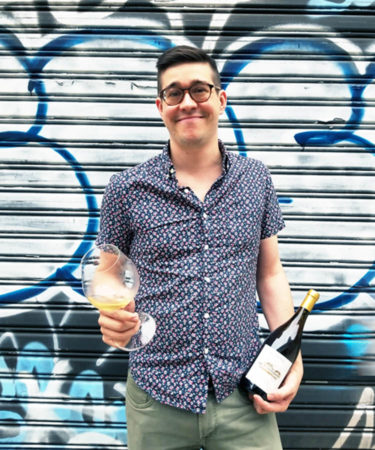Head down to New York City wine industry hangout La Compagnie des Vins Surnaturels, and your server will more likely be wearing a Hawaiian shirt or a track jacket than a perfectly pressed three-piece suit. Just ask James Sligh, who’s been opening bottles and spreading his love for all things Chenin at the hip, laid-back bar since fall 2017.
A New York–based sommelier, writer, and educator, Sligh turned his passion for wine into a career in 2014 after spells as an English teacher, coffee shop cook, and magazine fact checker. He cut his industry teeth working in the esteemed cellar at Patrick Cappiello’s now-defunct Pearl & Ash on the Bowery.
In June 2016, working alongside Master Somm Pascaline Lepeltier, Sligh helped reopen wine destination Rouge Tomate in Chelsea. The restaurant went on to win World of Fine Wine’s Best Long Wine List in the World in 2017. During this time with Lepeltier, Sligh’s love for farming-focused wine, small producers and (of course), Chenin Blanc was cemented.
From pondering what he would drink if wine were no longer an option, to reflecting on what constitutes a “best” or “worst” wine, Sligh is every bit as affable and down to earth as the bar where he works. We caught up with him to hear:
1. What’s the bottle that made you fall in love with wine?
It was a manzanilla sherry, for maybe a euro, handed over to me in a tiny glass in a bar in Jaén by the art teacher at the rural school I was working at, along with a bunch of fried squid and a lemon wedge. It was salty and fresh and tasted like the sea, and it was perfect in that moment, with that food, and I had never had anything like it. And my eyes popped open.
2. FMK three varieties: Cabernet, Pinot Noir, Chardonnay
Fuck Chardonnay. It’s a variety that’s easy to grow and a lot of bad things have been done to it and said about it, but it’s flexible and there’s a huge range of styles and there’s no reason you two can’t have a respectful, mutually consenting weekend full of fun. Marry Pinot Noir. Now there’s something you could spend your entire life with and still be finding new things out about. It can be tricky in the vineyard, but it will be a partner to you if you’ll partner it. Kill Cabernet (Sauvignon). The enormous bonus of killing Cabernet is that you take down as collateral damage a whole tribe of people, usually people with a lot of money and no curiosity, who think it’s the only wine on the planet that’s worth buying or talking about.
3. You’re on death row. What’s your last-supper wine?
Old Huet. The greatest producer, bar none, of Chenin in his region since 1929; wines of grace and profundity and infinite surprise. As long as we’re dreaming here, let’s say 1945 Haut-Lieu. 1945 is the year that Gaston Huet literally walked home after five years in a German POW camp to find his vineyard in disarray, unpruned vines on unplowed soils, and sat down and made one of the great wines of his century. Wine can be time travel. What else am I going to do before I die?
4. You can only drink one wine for the rest of your life. What is it?
Chenin. I don’t want to pigeonhole myself, but this is the rest of my life I’m talking about. The stakes are too high to drink anything else.
5. You can only drink at one bar for the rest of your life. What is it?
Got to make sure it’s walking distance from my apartment, so Four Horsemen in Williamsburg. One of the great wine lists in Brooklyn if not all of New York, and even if I stop drinking, their tea program is outstanding.
6. What’s the best and worst wine on your rack (or in your fridge) right now?
With the big blinking-lights caveat that I really don’t like thinking about wine in terms of best and worst: “Best” is a bottle of Champagne from a woman named Marie-Noëlle Ledru. It’s a particular bottling from her, a blanc de noirs named “Goulté” from 2008. She’s a one-woman operation who farms and bottles everything basically herself, from tending the vines to riddling by hand to disgorging, and she’s in the process of retiring. After I open this bottle, there’s a good chance I’ll never taste it again.
I just took a look in my refrigerator and I’m going to say that the worst wine I have right now, as long as we’re talking Champagne, is the regular brut réserve from Billecart-Salmon. Basically, everything else aside from this I keep at home has a reason for being here (I’m not throwing that bottle of sweet Michigan rosé I brought home from Christmas under the bus!), and I’m not saying that Billecart is bad, or whatever. It’s just a commodified luxury brand, it’s expensive, and I don’t really care about it.
7. If you could no longer drink wine, what would be your beverage of choice?
Realistically, I’d continue drinking lots and lots of beer. But between diversity of style and the idea of terroir, if wine disappeared from the world I would look to cider. I grew up in Michigan and live in New York, and cider is our true indigenous beverage: The land is right for it, there’s history, you can get complexity and varietal difference and age-worthiness. It’s really hard to get people to go to bat for cider, which is a shame, but it’s worth fighting for.
